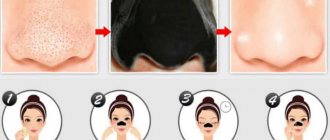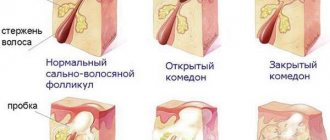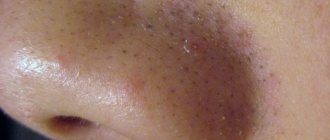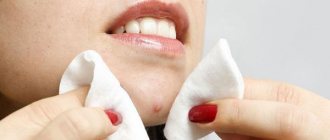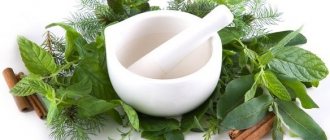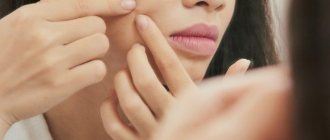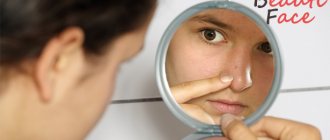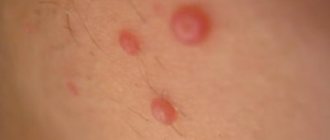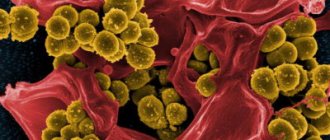- Is it possible to prick pimples with a needle?
- Possible negative consequences of pimple piercing
- How to know when a pimple is ready to pop
- How to pierce pimples correctly
Pimples on the surface of the face can be presented either in the form of red, highly inflamed pustules (filled with pus) or simply inflamed red or white regular pimples. In any case, you, as a person susceptible to any of these inflammations, are looking for the easiest, simplest and fastest way to get rid of this cosmetic embarrassment, which, undoubtedly, in your opinion, is visible in the eyes of the people around you even from space.
For many people, the answer to solving the problem of acne is obvious: the fastest way to get rid of acne is by squeezing or piercing with a needle. And for many, this process has also become a somewhat perverse pleasure and a very strong habit. Further in the article we will figure out whether it is possible to pierce a pimple, and if so , then how to do it as safely as possible!
Is it possible to prick pimples with a needle?
Unfortunately, the skin does not always respond well to this type of acne treatment. Most dermatologists do not recommend needle piercing of acne because it can lead to scarring or other breakouts. Of course, we are not talking about medical intervention, but about doing it yourself at home. certain risks.
For example, when squeezing pimples, your nails can tear the skin, or your fingers can redistribute bacteria onto your face. After all, dermatologists often cite the cause of acne flare-ups as a factor in the complications of improperly squeezing or piercing a pimple.
There are many over-the-counter acne treatments, such as salicylic acid, that you can use to prep the skin and position it for safe needling, for both those who wear makeup and those who don't wear it as often.
However, there are many people who incorrectly pierce or squeeze out a pimple, thereby causing irreparable harm and consequences in the form of new acne on the face and body. In order to secure this procedure for getting rid of a pimple by piercing with a needle or squeezing out a pimple with your fingers, follow the following recommendations:
- Use cotton swabs instead of your fingers when you pop a pimple. This will help keep bacteria from transferring from your hands to your face.
- Buy a comedone extractor This is a tool that some dermatologists use to remove whiteheads and pimples. It can be purchased online and in many pharmacies. Also, be sure to follow the instructions that come with it.
Perspective
Pimples and acne are common, and it is estimated that 80% of people aged 11 to 30 will suffer from a flare-up at some point.
Overall, the outlook for people dealing with acne is good. For most people, these types of acne develop and disappear fairly quickly.
Blackheads or whiteheads are generally considered to have mild acne. Moderate acne includes nodules, papules and pustules. Severe acne is when a person has tender, red nodules that can be painful.
In more severe cases, scarring is possible. Scars may be flat and barely noticeable, or if the connective tissue is damaged, scratches or dents may form.
If at-home treatment doesn't work within 4 to 8 weeks, the American Academy of Dermatology recommends seeing a dermatologist to find out what course of treatment is best.
Possible negative consequences of pimple piercing
Poll: When did your acne appear? (Number of votes: 4295)
I've been suffering all my life
It's been a couple of years now
About a few months
Recently
To vote, click on the desired answer. results
- Slow Healing: Poking a pimple can activate bacteria and push them further down the pores, creating a deeper infection. You can also produce new strains of bacteria on your skin from dirty fingers or tools in your piercing scars. Either way, your body may be required to even more time to get rid of the infection and heal the wounds and consequences of acne.
- Spreading Infection: When you rupture the pimple sac, which contains oil, debris and bacteria, as well as the material that fills the pimple, all of this can get into your other pores, increasing the likelihood of more pimples.
- Bruising and Scarring: Any damage to the skin, especially piercing, can not only leave you vulnerable to more bacteria, but also puts you at risk for long-term skin discoloration and scarring. Plus, a oozing wet pimple is nearly impossible to hide.
About ways to quickly get rid of pimples overnight!
Hard pimple on the back of the neck. Pimples on the back of the neck
Such a problem as acne on the back of the neck most often occurs in the summer, when the body secretes especially much sweat. Such pimples usually appear along the hairline and, like subcutaneous pimples, on the palms. they look like small red dots, sometimes with an abscess in the center.
Why do pimples form on the back of the neck?
The reasons that rashes appear on the back of the neck are interrelated:
1. Folliculitis. The internal cause of folliculitis is a disruption of the endocrine system, as a result of which the body becomes susceptible to skin damage by harmful bacteria, such as Staphylococcus aureus. The skin on the back of the necks, when in contact and friction with clothing, receives microtraumas, into which the infection penetrates, causing point inflammation.
2. Ingrown hair. When the back of the neck rubs against clothing, the hairs are partially abraded and deformed, which provokes their ingrowth and, consequently, an inflammatory process. Ingrown hair is not at all easy to remove, especially if you suffer from acne on your neck. Here you need to contact a qualified specialist who will help remove the swelling from the pimple. remove and neutralize inflammation.
Preventative measures for acne that forms on the back of the neck
1. Hygiene. Wash problem areas thoroughly with soap, preferably with an antiseptic effect. Change and wash clothes every day, paying special attention to collars, because this is where a huge amount of dirt and bacteria accumulates. Use any cream with an antibacterial effect at night.
2. Avoid hard collars on shirts to avoid injury to the skin, and be sure to cut off the tags from clothing, which are usually sewn on the back of the collar. These labels are hard and can damage the skin. It is better that the fabric of the clothing is natural, breathable, and as soft as possible.
3. If you have long hair, and acne appears in the hot season, then it is better to choose a high hairstyle so that less sweat is generated on the neck.
4. Seek advice from an endocrinologist, because acne on the neck, especially if it is located not only on the back, can be the result of a serious disruption in the functioning of the endocrine gland systems.
How to know when a pimple is ready to pop
First, you need to evaluate the pimple:
When a pimple has a soft white head on top of the pimple, and if the pimple has been mature for at least 2 days, then it means that the pus is close to the surface of the skin and is ready to be poked.
Do not try to squeeze out a pimple prematurely or if it takes the form of a subcutaneous or non-purulent pimple. Since such pimples are in the form of deep, infected bumps that are much below the surface of the skin, their purulent contents are located deep in the pore canals, when punctured or squeezed out, it spreads contents inside the skin, which only causes new acne to appear.
Causes of acne
When a pimple appears on the surface of the body, it means that the activity of the sebaceous gland is disrupted. In this case, the outflow of sebum stops, and propionbacteria begin to develop inside the pore, causing inflammation. These microorganisms live on the surface of the epidermis; when the gland is clogged, an ideal environment for their active reproduction is formed in the upper layer of the skin. These are anaerobic organisms, that is, they do not require oxygen.
Doctors name several of the most common causes of acne and other similar formations:
- Poor nutrition. Abuse of fast food, sweets or flour products, as well as excessive consumption of coffee and alcohol (including low-alcohol drinks) leads to disruption of the sebaceous glands. With their hyperfunction, fat does not have time to be removed to the surface of the skin, the channels become clogged and local inflammatory processes begin.
- Care that does not match your skin type and characteristics. Incorrectly selected cosmetic products, frequent and excessive use of powder and foundation lead to blockage of the sebaceous ducts, resulting in pimples.
- Hormonal disorder. As you know, hormones are specific substances that regulate most body processes. If a woman has a lot of male hormones (testosterone and dihydrotestosterone), her skin becomes too oily, the pores close with sebaceous plugs and acne and comedones (so-called “blackheads”) appear. It is hormonal imbalance that causes acne during adolescence. If a lot of pimples form on a woman’s body for no apparent reason, she needs to immediately make an appointment with a gynecologist and endocrinologist.
- Diseases and stress. Since everything in the human body is interconnected, it should not be surprising that the effects of lack of sleep and nervousness, or digestive problems appear on the skin surface.
- Subcutaneous mite - demodex. It lives in the upper layer of the epidermis and provokes inflammation. Pimples form at the site of its bites and where waste products of this parasite accumulate.
The best way to combat pimples is to identify and eliminate the cause that caused them. That is, we need therapy from the inside. Cosmetics and procedures for eliminating acne, comedones and others help solve the problem locally. But you must understand that if you do not find the root cause of the skin problem, then having gotten rid of one pimple, you will soon have to deal with another.
How to pierce pimples correctly
Step 1
First of all, you need to disinfect the needle and hand before piercing the pimple. Start by disinfecting the thin needle and hands in an alcohol solution. It is easiest to pour some of the liquid into the cap. Allow the needle to sit in the alcohol for a while while you complete the following steps.
Step 2
Many dermatologists first recommend steaming pimples and skin in a hot bath, whereby the steam and heat from the flow of water will help relax the pores and soften the skin around the pimple.
It is also recommended to apply a warm compress directly to the area where the pimple appears: start by soaking a washcloth in hot water and applying it to the pimple Apply the compress to the pimple for 20 minutes You will need to constantly wet the washcloth with hot water and change the compress to a new one every few minutes This procedure will soften the skin and will bring pus to the surface even without the need to pierce with a needle.
Step 3
Wash your hands thoroughly with an antibacterial soap such as Dial and dry your hands using a paper towel. Never dry your hands on an air towel, as such drying will only accumulate new bacteria on your hands.
What fills and what is inside your pimple!
Step 4
Disinfect the area with a cotton swab soaked in toner or hydrogen peroxide Avoid using alcohol on your face as it will dry out the area or cause a slight burn to the skin Once everything is clean, you can proceed directly to getting rid of the pimple.
Step 5
Remove the disinfected needle from the bottle cap with isopropyl alcohol and use it to prick the pimple. Since the skin has been softened with a warm hot compress, the needle should enter the skin with little resistance and little pain. About 1/4 inch of the tip of the needle should enter the skin to release the contents pimples and bacterial infections that have formed under the surface of the skin.
Step 6
Draining a pimple is a gentle process where pus begins to appear as soon as you remove the needle from the pimple. Light pressure is required to drain the pus from the skin duct. Place a finger on each side of the pimple and move your fingers in a circular motion towards the blemish while pressing lightly on the pimple. Repeat this process with different angles.
Erythromycin ointment for acne!
You should not squeeze the pimple with force, otherwise the pus will only penetrate deeper into the skin. This will make the pimple even worse, causing scarring after such actions. If you gently squeeze the pimple, but nothing comes out of it, you need to apply a compress for 20 minutes and then try again piercing a pimple If pus still does not appear from the acne, it means that the pimple is not yet ripe and is not ready to drain.
Step 7
Once you have cleared the pimple of pus, you should wipe it with a cotton swab soaked in isopropyl alcohol.
How to make a puncture correctly?
With any intervention in the skin, it is important to remember that disinfection always takes first place. It helps prevent negative consequences.
All instruments must be disinfected.
Before removing a pimple, you will need to disinfect the instrument that will be used for the procedure, the surface of the skin, hands and everything that will touch the affected area. You will need:
- needle;
- cotton wool or cotton pads, tampons;
- antibacterial agent, such as alcohol.
First, you should pay attention to whether the pimple is ready for a puncture. If it turns white, you can safely begin the procedure. If it is not ripe, it is recommended to postpone the operation for a day or two, otherwise you may get a scar on your face. Immerse the needle in alcohol or antibacterial agent for 10 seconds. It is correct to pierce pimples not from top to bottom, but horizontally, so that you get two holes. Try to make a puncture as close as possible to the top of the abscess. Pus should flow out of the holes; you can press lightly, but you should not do this from above, because the risk of infection is greater. Gently press on the bottom sides of the pimple. After the pus has drained, cauterize the area and treat with an antiseptic or salicylic acid.
Which ones should not be pressed?
Not all pimples can be removed with the listed devices.
What types of pimples should not be removed:
- Any rash in which the inflammatory process is clearly visible. First, you need to calm the epidermal cells as much as possible and eliminate active inflammation, and only then start squeezing out the pimple. In this situation, it is better to go to a beauty salon.
- Boils. These rashes are distinguished by purulent contents. An active inflammatory process develops in the boil.
- Carbuncles. When boils come together, a carbuncle is formed. You cannot treat it yourself! Moreover, you should not trust such education to a cosmetologist, but it is better to seek help from a dermatologist or even a surgeon.
- Pyoderma. In this case, inflammation affects the deep layers of the skin. As a rule, such rashes occur due to a combination of circumstances, including decreased immunity and microcracks in the skin. As in previous cases, this purulent rash should not be squeezed out on its own.
- Herpetic rashes. If the pimple is caused by herpes, then squeezing it out has a chance of spreading the infection to other areas of the skin.
- Cuperosis. In this situation, the purulent contents of the pimple can enter the bloodstream through dilated vessels, and therefore it is better to contact a professional.
And of course, if a person has a dermatological disease, and at the moment there is an exacerbation of it, then it is better to wait until it enters the stage of remission.
Why is self-medication of such acne dangerous? In addition to scars that may remain at the site of extrusion, a person faces serious complications, including blood poisoning.
Subcutaneous acne: why do they appear on the face?
Any subcutaneous pimple appears on the face due to clogged pores. Subcutaneous sebum, keratinized epithelial cells, particles of decorative cosmetics, various contaminants, etc. accumulate in the ducts, resulting in the formation of a plug and the development of an acute inflammatory process. There are many factors that provoke increased formation of sebum in the deep tissues of the skin:
- poor nutrition;
- hormonal changes;
- lack of hygiene;
- insufficient skin cleansing;
- incorrectly selected cosmetics;
- diseases of internal organs;
- bad eating habits;
- metabolic disease;
- taking certain medications, etc.

